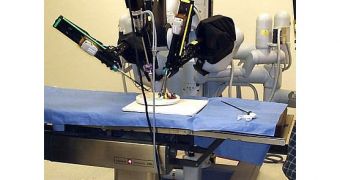Researchers from the University of Alabama at Birmingham said that, based on patient function and survival, robotic surgery for the upper airway and digestive track malignant tumors is less invasive and just as efficient as other minimally invasive surgical techniques.
J. Scott Magnuson, MD is an UAB otolaryngologist and the study's senior author, and along with colleagues from UAB and the Mayo Clinic assessed 89 patients with several stages of head and neck squamous cell carcinomas, who had their primary tumor resected by the da Vinci Robot.
The patients were all monitored during their hospital stay and up to 33 months after the intervention.
Magnuson, who is also a scientist in the UAB Comprehensive Cancer Center, said that “the overall two-year survival rate for these patients was 86.3 percent, which is comparable to the standard treatment.
“Those with earlier-stage tumors appeared to have slightly better recurrence-free survival than those with later stages, but it was not statistically significant.”
He added that some patients recovered their ability to swallow faster than others and that this depended on the location of the tumor, on their preoperative swallowing ability, cancer stage and patient age.
This is why some patients could have an oral diet one day or two after the surgery, while some of them were discharged with a short-term nasal feeding tube or long-term gastric feeding tube (patients who were feeding tube-dependent before the surgery included).
“Of note, all of the patients in the study had regained full swallowing ability at the time of the last follow up visit and none remained feeding-tube dependent,” Magnuson added.
Head and neck squamous cell carcinomas represent nearly 4 percent of the malignant tumors diagnosed in the United States every year, and the current standard minimally invasive surgery is transoral laser microsurgery.
Magnuson said that the results of this study are very encouraging, and prove that robotic surgery is a viable alternative treatment for some patients with head and neck squamous cell carcinomas.
On the other hand, he adds that more work needs to be done, because “this is a relatively new technique, and long-term oncologic outcomes are not available.
“However, the early functional and oncologic results justify the continued treatment of select patients with head and neck squamous cell carcinomas with robotic-assisted surgeries.”
This study was published in the Archives of Otolaryngology - Head & Neck Surgery.

 14 DAY TRIAL //
14 DAY TRIAL //